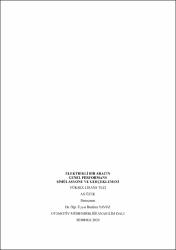Elektrikli bir aracın genel performans Simülasyonu ve gerçeklemesi
Abstract
Ulaşım insanların en temel ihtiyaçlarının başında gelmektedir. Bu temel ihtiyacın karşılanmasına yönelik yapılan çalışmalar teknolojinin de gelişmesine paralel olarak gün geçtikçe hızla artmaktadır. Son yıllarda elektrikli araçlara olan ilgilin artmasıyla da otomotiv teknolojisi bu alanda yoğunlaşmaktadır. Elektrikli araçlar son yıllarda gündeme gelse de 1800’lü yıllarda ilk örneklerine rastlanmaktadır. Ancak o yıllarda batarya teknolojisindeki yetersizlik gibi nedenler elektrikli araçlara olan ilgiyi azaltmıştır. Günümüzde ise petrol rezervlerinin azalması, çevre kirliliği, batarya teknolojisinin gelişmesiyle aşılan menzil sorunu gibi nedenlerden dolayı elektrikli araçlar tekrar gündeme gelmiştir.
Bu tez çalışmasında taşıtlarda kullanılan tahrik sistemleri incelenmiş ve simülasyonu yapılmıştır. Simülasyona göre belirlenen taşıt mimarisine uygun olarak elektrikli bir aracın matematiksel olarak modellemesi yapılmış, taşıt parametreleri belirlenmiş ve belirli yol şartlarına uygun olarak simülasyonu tamamlanmıştır. Taşıtın simülasyonu MATLAB/SIMULINK ortamında modellenmiştir. Belirlenen taşıt parametrelerine uygun olarak taşıtın tasarımı SOLIDWORKS programında yapılmıştır. Son olarak simülasyonun doğrulanabilmesi için tasarımı yapılan taşıtın imalatı gerçekleştirilmiştir.
İmalatı yapılan taşıt üç elektrik motoruyla tahrik edilmektedir. Ön tekerleklerin her birinde 1.2 kW tekerlek içi BLDC motor, arka tekerleklerin tahriki için ise diferansiyele bağlı olarak 2.5 kW BLDC motor kullanılmıştır. Motorların ihtiyacı olan enerji 6 adet 12V 40 Ah kurşun jel aküden sağlanmaktadır. Tasarımı ve imalatı yapılan taşıt parametrelerine uygun olarak modellenen taşıt üç farklı tahrik sistemine göre NEDC çevrimin şartlarına uygun olarak simülasyonu tamamlanmıştır. 4WD tahrik sistemi daha verimli olduğu görülmüştür. Bu tahrik sisteminde ön tekerleklerde bulunan motorlar maksimum 17 Nm tork ve 0.7 kW güç gereksinimlerine ihtiyaç duymaktadır. Gerçeklemesi yapılan taşıt 4WD olarak simülasyonu tamamlamış ancak RWD ve FWD tahrik sistemlerinde istenilen hıza ulaşamamıştır. RWD tahrik sisteminde NEDC çevrimine göre elektrik motoru maksimum 33.17 Nm tork ve 3.17 kW güce ihtiyaç duyarken, FWD tahrik sisteminde ise motorların her biri 45.14 Nm tork ve 1.9 kW’lık bir güce ihtiyaç duyulmaktadır. İmalatı yapılan taşıtta kullanılan motorlar da bu değerlere ulaşılamamıştır. Transportation is one of the most basic needs of people. Efforts to meet this basic need are increasing day by day in parallel with the development of technology. With the increasing interest in electric vehicles in recent years, automotive technology is focusing on this area. Although electric vehicles have been on the agenda in recent years, the first examples can be found in the 1800s. However, in those years, reasons such as the inadequacy of battery technology decreased the interest in electric vehicles. Today, electric vehicles have come to the fore again due to reasons such as the decrease in oil reserves, environmental pollution, and the range problem that has been overcome by the development of battery technology.
In this thesis, propulsion systems used in vehicles were examined and simulated. Mathematical modeling of an electric vehicle was made in accordance with the vehicle architecture determined according to the simulation, vehicle parameters were determined and the simulation was completed in accordance with certain road conditions. The simulation of the vehicle is modeled in MATLAB / SIMULINK environment. The design of the vehicle was made in the SOLIDWORKS program in accordance with the specified vehicle parameters. Finally, the designed vehicle was manufactured so that the simulation could be verified.
The vehicle manufactured is driven by three electric motors. A 1.2 kW in-wheel BLDC motor is used on each of the front wheels, and a 2.5 kW BLDC motor is used for the drive of the rear wheels, depending on the differential. The energy needed by the motors is provided by 6 12V 40 Ah lead gel batteries. The vehicle, which is modeled in accordance with the vehicle parameters designed and manufactured, has been simulated in accordance with the conditions of the NEDC cycle according to three different drive systems. The 4WD drive system has been found to be more efficient. In this drive system, the motors on the front wheels need a maximum of 17 Nm of torque and 0.7 kW of power. The vehicle implemented has completed the simulation as 4WD, but could not reach the desired speed in RWD and FWD drive systems. According to the NEDC cycle, the electric motor needs a maximum torque of 33.17 Nm and a power of 3.17 kW in the RWD drive system, while the FWD drive requires 45.14 Nm of torque and a power of 1.9 kW each of the motors. These engines used in the manufactured vehicle could not reach these values.
Collections
- Yüksek Lisans Tezleri [890]



















